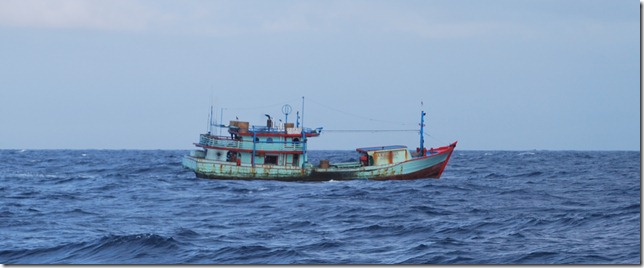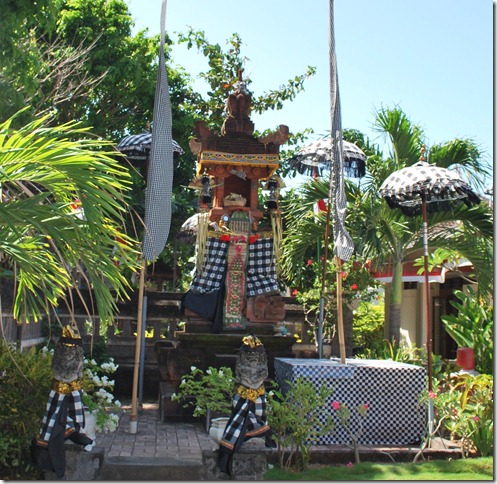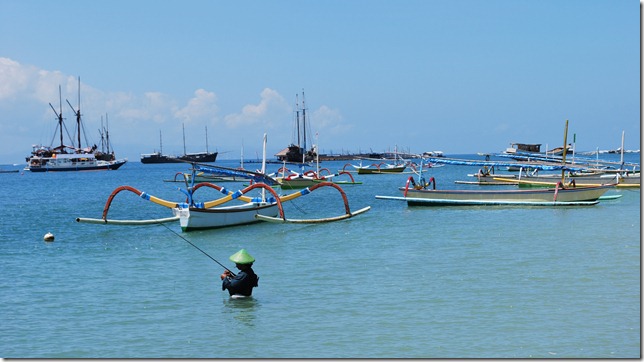For a sailor, one’s first impression of a country is a bit different than for the tourist that arrives via an international airport. The sailor’s first impressions include the sight of land from offshore when the hazy outline of the much anticipated landfall can barely be made out, the port officials and procedures, the first restaurant meal, the price of a cold beer, the shower situation, and of course, the flag. International conventions call for raising the yellow ‘Q’ (Quarantine) flag as well as the courtesy flag for the country being visited when the 12 nm limit is reached. Bali’s flag is unique in it’s simplicity: top half red, bottom half white. That’s it. It’s simple enough that if you didn’t know it was a country flag you could easily mistake it for one of the standard nautical signaling flags. I would say you could conclude from this that Bali isn’t a pretentious country, but we all know what adding a blue bar and turning things 90 degrees results in (France), so that’s probably a stretch (on a side note, we’ve really enjoyed the French people we’ve met on our trip).
As for the other initial impressions, I sighted land at sunrise when we were only about 20 miles from Bali. Southern Bali is low-lying and not yet visible, but I could clearly see the steep coast of the neighboring high island of Nusa Penida. The sight of land, however, was less impressive than the sea state. The good luck with tides that we’d enjoyed when approaching Darwin had abandoned us and we found ourselves fighting a strong tidal current that was running against the tradewinds. The result was steep seas and a course over ground (COG) that was about 120 degrees off of our heading. After changing sails and starting an engine, we got up to a whopping 1.8 knots in the right direction. We were shadowed in our approach to Bali by a local fishing boat that was returning to port. Even though they were 2-3 times our length, the colorful craft was only making about 3 knots. By the time things were done we’d taken different courses and lost sight of them, but as we entered the channel to Benoa harbor, we had to slow to let them pass and enter ahead of us. In the US, a boat this size would have outdistanced us easily, but here it was just crawling along.
 Finally a moderate sized vessel that’s no faster than we are
Finally a moderate sized vessel that’s no faster than we are
 Even this less popular beach was crawling with tourists
Even this less popular beach was crawling with tourists
The Bali International Marina is the smallest “marina” we’ve ever seen and there’s virtually no place to anchor, so we motored around for a bit before they finally found a spot we could tie up until 6am the next morning when we had to leave to make room for an arriving motor vessel. Oh well. It was an easy tie-up on an the outside edge of a dock that was nearly turned into a near-disaster by yours-truly. I had the boat pointed into the wind with the engines barely above idle to sort of keep us in place while we readied the docklines and fenders (we’d originally planned to anchor). When we were almost done, a large local ship was leaving a wharf about 100 feet away and started yelling at us to get out of the way. I’m not sure exactly what I was so preoccupied with (could have been the effects of getting up at 3am), but I forgot that the autopilot was engaged and started trying to up throttle and steer the boat away when I found that the steering wouldn’t budge – it was stuck and at the worst possible time. After signaling to the vessel that our steering was stuck, I finally maneuvered out of the way using the two engines and then started toward the dock using only the engines to steer. Within seconds of getting out of harms way I realized what was happening and turned the autopilot off. Definitely one of the dumbest things I’ve ever done in my life.
Clearing into Bali is a topic of much concern among cruisers for several reasons: (1) you have to have a $200 US cruising permit in hand before arriving that can take more than 4 weeks to get (we received ours in Cairns), (2) bribes (both as direct requests and also as fake fees/charges/fines) are not uncommon, and (3) there is an Indonesian law that has been on the books for a few years that requires yachts to pay a temporary bond of something like 30-40% of the boat’s value. Because this is Indonesia, the enforcement of that law is on a port-by-port, official-by-official, case-by-case basis. If you’re lucky, it’s no worries. If you’re not, it’s a huge bill for which the refund mechanism is anything but clear. You can pay $200-$300 to have a local “agent” sort it out for you and guarantee no problems, but that’s a bit of a rip-off in itself, so we did as usual and tried the clear-in on our own. As it turned out, we did just fine. Our first stop was immigration, where the officer was wearing a T-shirt and flip-flops. He later apologized for his attire (“I sorry, me no wear uniform today. Benoa too hot!”) He wanted us to pay $50 US and leave our passports, promising that he would bring them over to the marina later in the day with the our 30-day visas. This seemed a little odd, but he was an incredibly nice and relaxed guy and the price was in line with what Lauren had researched, so we went along and proceeded to the next office. We found everyone friendly and laid-back, especially after being greeted in their own language. It’s a general rule of mine to always greet officials in their own language when checking in and it almost never fails to make them smile and start things off with a friendly air. The local language is a little difficult because each greeting is only used for a few hours during the day (e.g., selamat siang from 12pm-2pm), but it worked out well. I did begin to doubt we could get the job done in the few afternoon hours we had left after immigration stamped each of the 5 copies of our crew list with 4 different stamps and then had to hand-write details into the blank field from several of the stamps. In the end, the crew lists that we kept ended up with 10 official stamps from a total of 5 different offices (harbormaster, immigration, customs, quarantine, and navy). The total charge was $2 US at quarantine and no requests for bribes.
 Shrines like this are everywhere, including on the grounds of government buildings
Shrines like this are everywhere, including on the grounds of government buildings
After failing to find a good spot to anchor, we’ve moved to a nice place that Kirk on S/V Salsa told us all about on the radio called Serangan. It’s relatively quiet (Bali Marina has fog horns blasting at 4am when local ships leave the wharf) and the people are really nice. We’ve been eating out twice already as meals are $2-$5 at the expensive marina restaurant and drinks are cheap as well. Somehow it seems that we always spend more in the cheaper places, but it’s nice to be having great restaurant food at such cheap prices. We enjoyed our first night of sleep even if we did have to get up at 6am, and soon we should be relaxed and recharged enough to venture farther into Bali.


